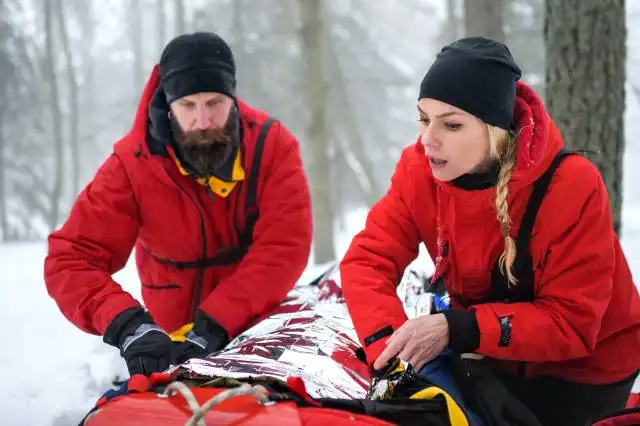Start a Wilderness Training Business
Crafting Your Own Odyssey: The Thrills of a Wilderness Training Venture
| Updated


WILDERNESS TRAINING BUSINESS
Embark on an exciting entrepreneurial journey with a Wilderness Training Business! In this vivacious venture, immerse yourself in the great outdoors while teaching others essential survival skills. Your business involves conducting dynamic sessions on hiking safety, navigation, wilderness first aid, and surviving in different environmental conditions. Imagine making a living from the roar of campfires, the whisper of the woods, and the thrill of guiding intrepid adventurers through their own slice of the wild unknown!
Jump to Business Plan
RELATED BUSINESS IDEAS
Browse ALL Education & Learning Platforms Business Ideas
Discover Your Perfect Domain
Unlock the door to your online success with our hand-picked selection of premium domain names. Whether you're starting a new venture or rebranding an existing one, the right domain can set the tone for your digital presence. Browse through our curated list, each with its unique potential to enhance your brand's visibility and credibility.
WILDERNESS TRAINING MINI BUSINESS PLAN
This a quick reality check to help you identify the strengths and weaknesses of your business concept before you dive in.
Expected Percent Margin:
- Gross Margin: 40-60%
- Net Profit Margin: 15-30%
Earnings Expectations:
- Daily Earnings (assuming an average of 2 classes/day): $200 - $600
- Weekly Earnings (assuming classes are held 5 days/week): $1,000 - $3,000
- Monthly Earnings: $4,000 - $12,000
- Annual Earnings: $48,000 - $144,000
Actions to Hit Those Numbers:
Course Content Development and Delivery:
- Course Variety: Develop at least 5-10 different courses covering various aspects of wilderness training.
- Instructors: Hire 1-2 experienced and certified instructors.
Marketing and Customer Acquisition:
- Online Presence: Have a well-designed website and active social media presence, posting at least 3 times a week.
- Partnerships: Partner with local outdoor gear shops, travel agencies, and schools for referrals and promotion.
Sales and Customer Experience:
- Pricing: Price courses competitively, based on local market rates and the level of expertise offered.
- Group Discounts: Offer group discounts to attract families and corporates for team-building sessions.
Cost Control:
- Equipment: Invest in good quality, durable equipment. Ensure regular maintenance to prolong life.
- Insurance: Ensure you have liability insurance to cover potential accidents and injuries.
Business Operations:
- Operation Days: Run courses at least 5 days a week. Consider weekend special courses or sessions.
- Course Size: Maintain an optimal student-teacher ratio - aim for 10-15 participants per course.
Like before, these are generalized estimations and the actual values can vary based on many factors. Consultation with a financial advisor is always recommended for personalized, accurate advice.
NOT WHAT YOU HAD IN MIND? Here are more ideas



Browse ALL Education & Learning Platforms Business Ideas
Grab Your Business Website Name
Before you get caught up in the whirlwind of setting up your business, invest in a domain name. It's a small but significant step that lays the foundation for your brand and makes it easier for customers to find and trust you. Just like you wouldn't build a house without securing the land first, don't build a business without securing your domain name.
"Why? Can't that wait?" Here's why it shouldn't
Step 1: Determine if a Wilderness Training Business is Right for You
Breakdown of Startup Expenses
When considering starting a wilderness training business, it is important to understand the startup costs associated with the venture. This includes expenses such as licenses and permits, equipment, insurance, and marketing. Licenses and permits will vary depending on the location and type of business, but can include things like business licenses, permits to use public lands, and permits to use private land. Equipment will also vary depending on the type of business, but can include things like tents, sleeping bags, backpacks, and other camping gear. Insurance is also important to consider, as it can help protect the business from potential liabilities. Finally, marketing expenses should also be taken into account, as this is an important part of getting the business off the ground.
Breakdown of Ongoing Expenses
In addition to startup expenses, it is important to consider the ongoing expenses associated with a wilderness training business. This includes expenses such as rent, utilities, salaries, and supplies. Rent and utilities will vary depending on the location and size of the business, but should be taken into account when budgeting. Salaries should also be taken into account, as they will be necessary to hire staff to help with the business. Finally, supplies should also be taken into account, as they will be necessary to provide the services offered by the business.
Examples of Ways to Make Money
When starting a wilderness training business, it is important to consider how the business will make money. One way to make money is to offer classes and workshops. These can be offered on a one-time basis or as part of a subscription service. Another way to make money is to offer guided tours and trips. These can be offered on a one-time basis or as part of a subscription service. Finally, another way to make money is to offer consulting services. These can be offered on a one-time basis or as part of a subscription service.
Step 2: Name the Business
Naming a business is an important step in the process of starting a wilderness training business. It is important to choose a name that is memorable and reflects the mission and values of the business. It should also be easy to pronounce and spell. Additionally, it is important to make sure the name is not already taken, as this could lead to legal issues. To ensure the name is available, it is best to check with the local government and the United States Patent and Trademark Office to make sure the name is not already in use. Additionally, it is important to check the internet to make sure the name is not already in use by another business.
Once the name has been chosen, it is important to register the name with the local government. This will ensure that the business is legally registered and will protect the business from any legal issues. Additionally, registering the name will also help the business to be found in search engines and directories. Finally, it is important to create a logo that reflects the mission and values of the business. This logo will be used on all marketing materials and will help customers to remember the business.
Step 3: Develop a Business Plan
When developing a business plan, there are several components that need to be included. These components include an executive summary, a market analysis, a description of the business, a description of the products or services offered, a description of the management team, a financial plan, and a marketing plan.
Executive Summary
The executive summary should provide a brief overview of the business plan and should include the mission statement, a description of the products or services offered, the target market, the competitive advantage, and the financial goals. This section should be concise and should provide the reader with a clear understanding of the business.
Market Analysis
The market analysis should provide an overview of the industry and the target market. This should include an analysis of the size of the market, the competition, the potential customers, and the potential for growth. This section should also include an analysis of the industry trends and the potential for future growth.
Description of the Business
The description of the business should provide a detailed overview of the business and should include the business structure, the location, the products or services offered, and the management team. This section should also include a description of the business’s goals and objectives.
Description of the Products or Services Offered
The description of the products or services offered should provide a detailed overview of the products or services that the business will offer. This section should include a description of the features and benefits of the products or services, as well as the pricing structure.
Description of the Management Team
The description of the management team should provide a detailed overview of the team members and their roles within the business. This section should include a description of each team member’s qualifications and experience, as well as the team’s overall strategy for success.
Financial Plan
The financial plan should provide a detailed overview of the business’s financial goals and objectives. This section should include a breakdown of startup expenses, ongoing expenses, and potential sources of revenue. This section should also include a financial projection for the first three years of operation.
Marketing Plan
The marketing plan should provide a detailed overview of the business’s marketing strategy. This section should include a description of the target market, the marketing tactics that will be used to reach the target market, and the budget for the marketing efforts. This section should also include an analysis of the potential for success and the expected return on investment.
Step 4: Obtain Necessary Licenses and Permits
Before starting a wilderness training business, it is important to understand the licenses and permits that are needed to legally operate the business. Depending on the state, different licenses and permits may be required. For example, in some states, a business license may be required in order to operate the business. Additionally, certain permits may be needed in order to conduct wilderness training activities in certain areas.
Research Local Requirements
The next step is to research the local requirements for the business. This includes researching the local laws and regulations that apply to the business. Additionally, it is important to research the local zoning laws to ensure that the business is allowed to operate in the area. It is also important to research the local tax laws to ensure that the business is in compliance with all applicable laws.
Apply for Necessary Licenses and Permits
Once the research is complete, the next step is to apply for the necessary licenses and permits. This includes completing the necessary paperwork and submitting it to the appropriate government agency. Additionally, it is important to pay the necessary fees in order to obtain the licenses and permits.
Follow Up
Once the paperwork is submitted, it is important to follow up with the government agency to ensure that the paperwork is processed in a timely manner. Additionally, it is important to follow up with the government agency to ensure that the licenses and permits are issued in a timely manner. This will ensure that the business is able to legally operate in the area.
Step 5: Find a Location
Finding the right location for a wilderness training business is essential. It should be a place that is easily accessible, has plenty of outdoor space, and is safe for participants. It should also have access to amenities like restrooms, water, and electricity. Additionally, it should be close to other outdoor activities like hiking trails and camping sites.
Considerations for the Location
When choosing a location for a wilderness training business, it is important to consider the cost of renting or buying the space. It is also important to consider the availability of the space and the zoning laws in the area. Additionally, it is important to consider the local climate and the type of terrain the business will be operating in. Finally, it is important to consider the local wildlife and the potential impact it could have on the business.
Step 6: Purchase Necessary Equipment
When starting a wilderness training business, it is important to purchase the necessary equipment to ensure the safety of the participants. This may include items such as first aid kits, compasses, maps, and other navigation tools. Depending on the type of training offered, additional items such as climbing gear, tents, and other outdoor gear may be necessary. It is important to research the best quality items that will last for many years and will be able to withstand the elements.
Cost of Equipment
The cost of the necessary equipment can vary greatly depending on the type of training offered and the quality of the items purchased. It is important to research the best prices for the items needed and to compare prices between different retailers. It may be beneficial to purchase items in bulk in order to save money. Additionally, it may be beneficial to purchase used items if they are in good condition.
Maintenance of Equipment
Once the necessary equipment has been purchased, it is important to maintain it properly. This may include cleaning and inspecting the items regularly, as well as replacing any items that are worn or broken. It is also important to store the items properly in order to ensure that they remain in good condition. Additionally, it is important to keep track of any repairs or maintenance that needs to be done in order to ensure that the equipment is always in good working order.
Step 7: Market the Business
When it comes to marketing the wilderness training business, there are a variety of ways to get the word out. Examples include creating a website, utilizing social media, attending local events, and creating a referral program. A website should include information about the business, such as services offered, contact information, and pricing. Social media can be used to post updates, photos, and videos of the business. Attending local events is a great way to meet potential customers and build relationships. Lastly, creating a referral program can be a great way to incentivize customers to spread the word.
Tips for Successful Marketing
When it comes to marketing the business, it is important to be consistent. This means posting regularly on social media, attending events, and keeping the website up to date. Additionally, it is important to be creative and think outside the box. This could include creating a blog, offering discounts, or creating a loyalty program. Lastly, it is important to track the success of marketing efforts. This can be done by tracking website visitors, social media followers, and sales.
Step 8: Hire Employees
When it comes to hiring employees for a wilderness training business, it is important to hire individuals who have the right skills and experience. It is also important to make sure that the employees have the same passion for the business as the owner. When interviewing potential employees, make sure to ask questions that will help determine if they are a good fit for the business. It is also important to ask questions about their experience in the wilderness and their understanding of the safety protocols that need to be followed.
Benefits of Hiring Employees
Having employees can be beneficial for a wilderness training business. Employees can help with the day-to-day operations of the business, such as leading groups on hikes, teaching classes, and providing customer service. Employees can also help with marketing and promotion of the business, as well as helping to build relationships with potential clients. Having employees can also help to free up the owner’s time to focus on other aspects of the business.
Finding Employees
Finding the right employees for a wilderness training business can be a challenge. One way to find potential employees is to reach out to local universities and colleges to see if there are any students interested in working for the business. Another way to find potential employees is to post job listings on job search websites or social media. It is also important to network with other businesses in the industry to see if they know of any potential employees.
Training Employees
Once the right employees have been hired, it is important to provide them with the necessary training. This should include training on the safety protocols that need to be followed, as well as training on the company’s policies and procedures. It is also important to provide employees with training on customer service and how to handle difficult situations. Finally, it is important to provide employees with ongoing training to ensure that they are up-to-date on the latest industry trends and safety protocols.
Step 9: Monitor Business Performance
Monitoring the performance of a business is essential for success. It is important to track key performance indicators (KPIs) such as sales, customer satisfaction, and employee engagement. This will help to identify areas of improvement and areas of success. It is also important to track financial performance, such as revenue, expenses, and profits. This will help to ensure that the business is on track to meet its goals.
Tools for Monitoring Business Performance
There are a variety of tools available to help monitor business performance. These include software programs, such as QuickBooks and Xero, which can help track financial performance. Additionally, customer relationship management (CRM) software can be used to track customer satisfaction and engagement. Finally, surveys and other feedback tools can be used to measure employee engagement and satisfaction.
Benefits of Monitoring Business Performance
Monitoring business performance can help to identify areas of improvement and areas of success. It can also help to identify potential problems before they become too large. Additionally, tracking financial performance can help to ensure that the business is on track to meet its goals. Finally, monitoring business performance can help to ensure that the business is operating efficiently and effectively.
EXPLORE MORE CATEGORIES
Browse ALL Business Idea Categories
TAKE THE NEXT STEPS









